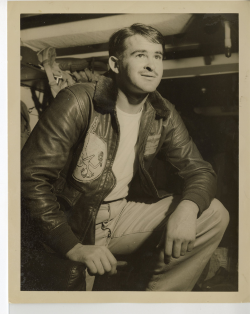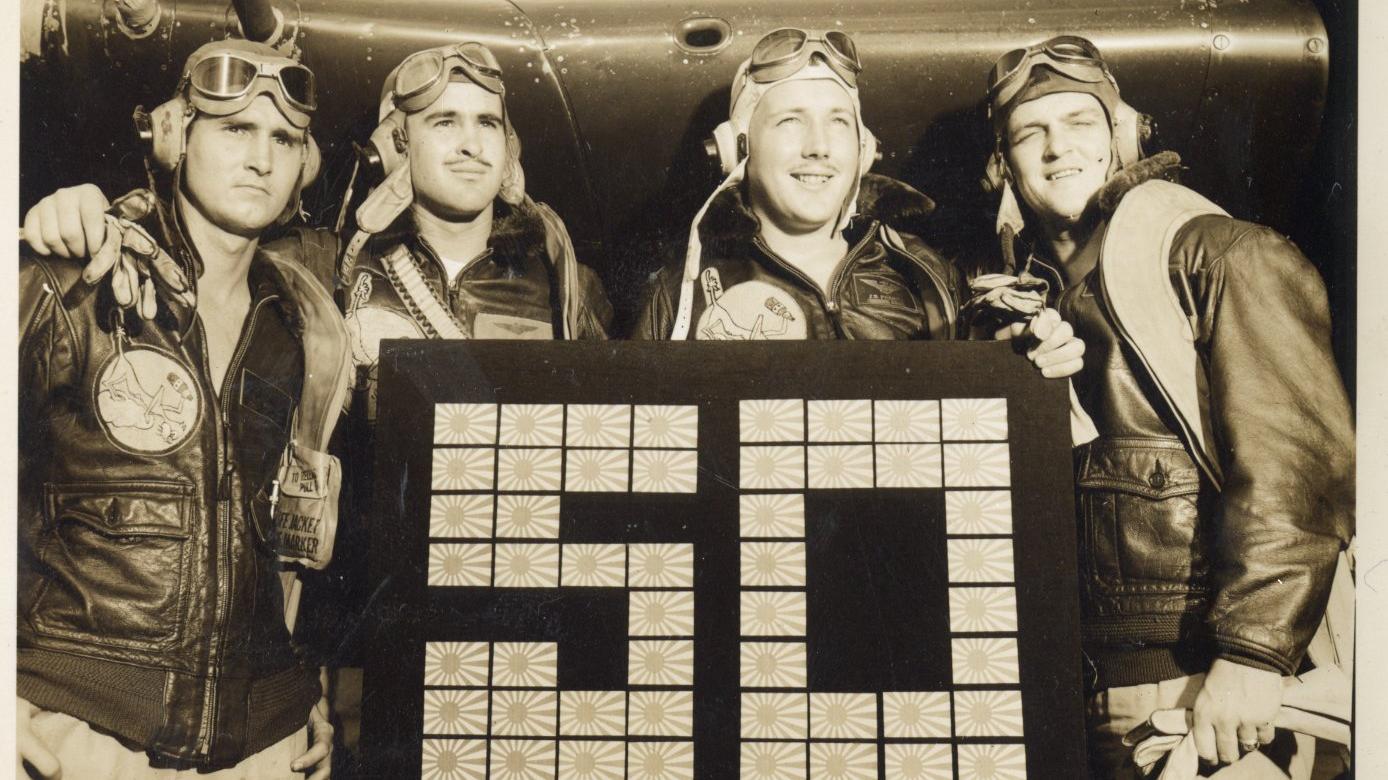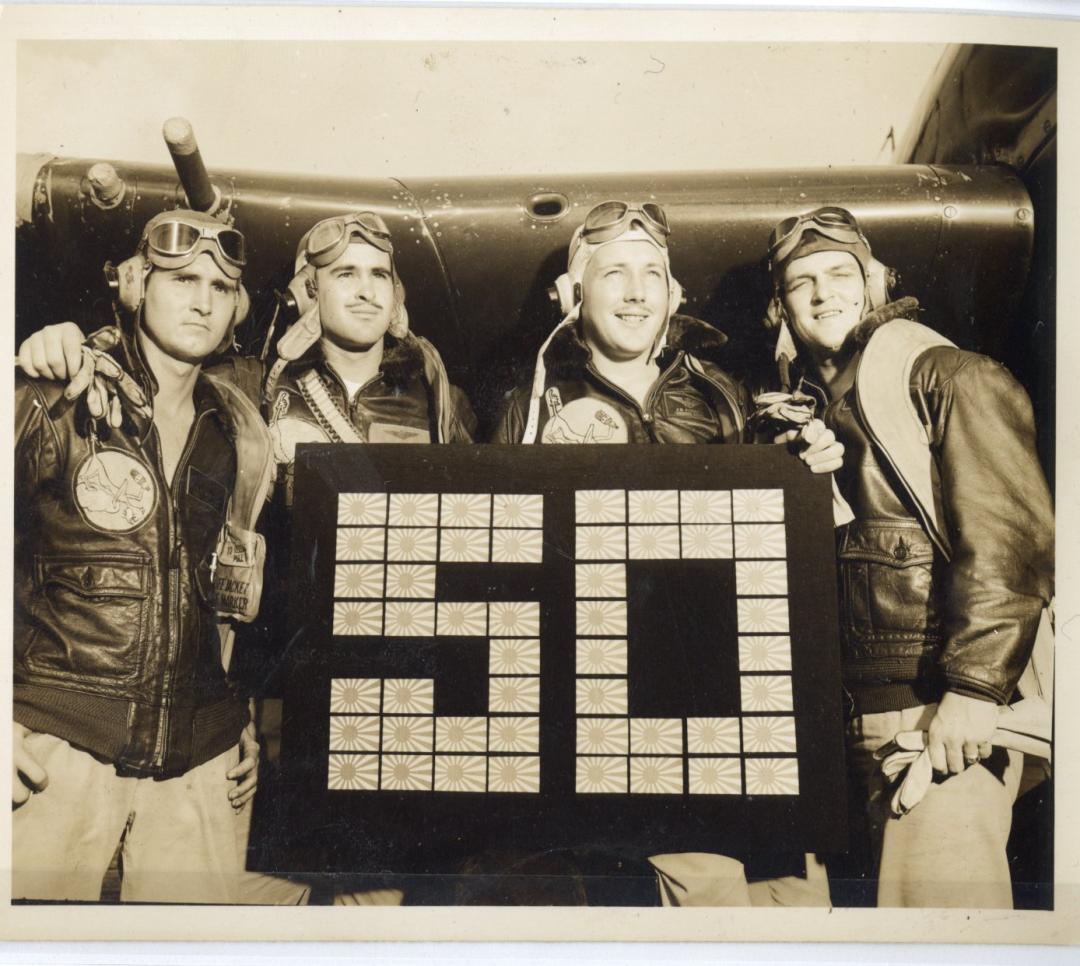New Virtual Reality & Flight Simulator Rides
Experience our new thrilling motion-based Virtual Reality and Flight Simulator adventures! Named in honor of USS Yorktown's Lieutenant Eugene Valencia and his legendary “Flying Circus” squadron of naval aviators, this immersive, action-packed experience is one the whole family will love.
Located in Hangar Bay 3 on the USS Yorktown. A separate purchase is required; tickets can be purchased at the museum’s ticket window.
The History of Valencia’s Flying Circus

By the time Lieutenant Eugene Valencia started his second tour in the Pacific theater, he was already a battle-hardened flying ace—a title given to those with five or more aerial victories. With seven confirmed air victories over Imperial Japan pilots, Valencia played an integral part in the rise of the U.S. Navy’s elite Fighting Squadron Nine (VF-9). His accomplishments during his first cruise earned him a promotion to lieutenant and placed him in command of the VF-9 division.[1]
In the U.S. Navy, fighter squadrons were comprised of four-pilot divisions—tight-knit groups that flew together, fought together, and kept each other alive. Valencia took his role seriously; he poured his combat experience into training the three junior officers assigned to his unit: James French, Harris Mitchell, and Clinton Smith. Together, these four aviators would come to be known as "The Flying Circus”—one of the most effective fighter divisions in Navy history and credited with 50 confirmed air victories by war’s end.
Valencia trained his division extensively, capitalizing on every opportunity for his men to gain more flight time before deployment.[2] Out of this training came an innovative tactic Valencia called the “Mowing Machine.” Imagine two pairs of fighters working in sync: while one pair dive in for the attack, the other circles above, ready to protect their teammates and strike if needed. Then, they switch roles. The pattern resembled the steady, sweeping motion of a mechanical mower—relentless, efficient, and devastatingly effective. This unique method, later dubbed the “fluid four” fighter tactic, allowed the Flying Circus to remain on the offensive while still providing surveillance for one another.[3] With disciplined teamwork, fresh tactics, and powerful aircraft, the Flying Circus was nearly unstoppable.
The Flying Circus would see some of its most frenzied combat while operating aboard the USS Yorktown (CV-10) in the spring of 1945. During this period, the Flying Circus would openly engage with much larger enemy formations, although their opposition was mostly comprised of inexperienced pilots and kamikaze planes. Harris Mitchell once recalled, “I discovered the true meaning of anxiety, when I looked over at Gene his expression was that of a young child who had just spotted his favorite toy under the Christmas tree.”[4] On April 17, 1945, the Flying Circus had their most effective day of the war, coming away with seventeen confirmed victories.
Valencia’s strategy and intense training produced unparalleled success; the members of the Flying Circus would claim fifty confirmed air victories altogether by the war’s end. Valencia would finish with a tally of twenty-three confirmed victories, making him the Navy’s third highest scoring ace of World War II.[5] While the achievements of the Flying Circus were due to a combination of factors, at the heart of the division were four pilots who inspired each other to be the best at their craft. Harris Mitchell recalled of Valencia, “Just to watch him in action instilled confidence in me.”[6]All four members of the division became flying aces by the time VF-9, and the Flying Circus said farewell to the USS Yorktown (CV-10) and headed home on June 17, 1945.[7]
[1] Stephen L. Moore. Rain of Steel: Mitscher's Task Force 58, Ugaki's Thunder Gods, and the Kamikaze War off Okinawa. (Annapolis, Maryland: Naval Institute Press, 2020.) 45.
[2] Barrett Tillman. Hellcat: The F6F in World War II. (Annapolis, Maryland: Naval Institute Press, 2000.) 215.
[3] Robert L. Shaw. Fighter Combat: Tactics and Maneuvering. (Annapolis, Maryland: Naval Institute Press, 1987.) 276.
[4] Clark G. Reynolds. The Fighting Lady: The New Yorktown in The Pacific War. (Missoula, Montana: Pictorial Histories Publishing Company, 1986.) 289.
[5] Ibid. 303.
[6] Stephen L. Moore. Rain of Steel. 333.
[7] Carrier Air Group Nine: March 1944-1945. 40.

